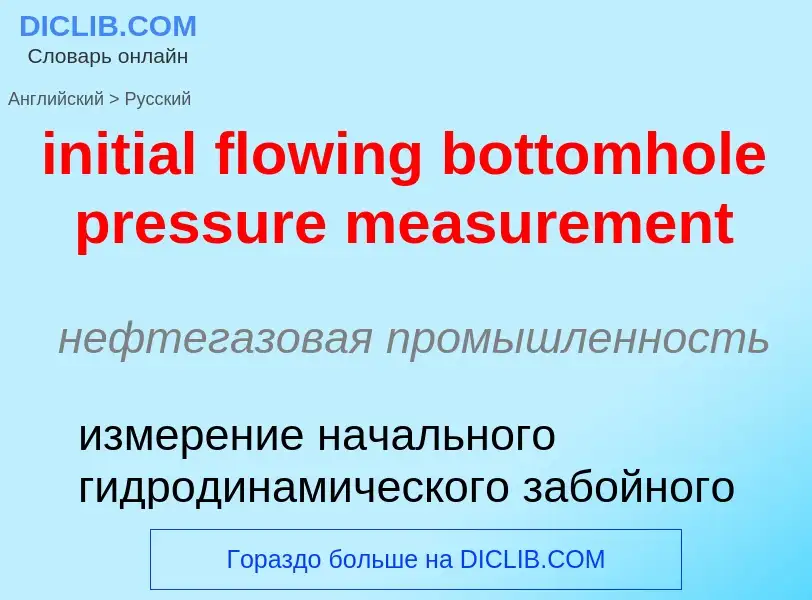Translation and analysis of words by ChatGPT artificial intelligence
On this page you can get a detailed analysis of a word or phrase, produced by the best artificial intelligence technology to date:
- how the word is used
- frequency of use
- it is used more often in oral or written speech
- word translation options
- usage examples (several phrases with translation)
- etymology
initial flowing bottomhole pressure measurement - translation to russian
нефтегазовая промышленность
измерение начального гидродинамического забойного давления
общая лексика
буквица, инициал "в оборку"
большая первая буква в начале главы или статьи. Имеет существенно большие размеры, чем остальные, и размещается так, что её верх находится на уровне первой строки абзаца. Если верх буквицы находится выше первой строки, то она называется initial
профессионализм
"фонарь"
Смотрите также
Definition
Wikipedia

Blood pressure (BP) is the pressure of circulating blood against the walls of blood vessels. Most of this pressure results from the heart pumping blood through the circulatory system. When used without qualification, the term "blood pressure" refers to the pressure in the large arteries. Blood pressure is usually expressed in terms of the systolic pressure (maximum pressure during one heartbeat) over diastolic pressure (minimum pressure between two heartbeats) in the cardiac cycle. It is measured in millimeters of mercury (mmHg) above the surrounding atmospheric pressure.
Blood pressure is one of the vital signs—together with respiratory rate, heart rate, oxygen saturation, and body temperature—that healthcare professionals use in evaluating a patient's health. Normal resting blood pressure, in an adult is approximately 120 millimetres of mercury (16 kPa) systolic over 80 millimetres of mercury (11 kPa) diastolic, denoted as "120/80 mmHg". Globally, the average blood pressure, age standardized, has remained about the same since 1975 to the present, at approx. 127/79 mmHg in men and 122/77 mmHg in women, although these average data mask significantly diverging regional trends.
Traditionally, a health-care worker measured blood pressure non-invasively by auscultation (listening) through a stethoscope for sounds in one arm's artery as the artery is squeezed, closer to the heart, by an aneroid gauge or a mercury-tube sphygmomanometer. Auscultation is still generally considered to be the gold standard of accuracy for non-invasive blood pressure readings in clinic. However, semi-automated methods have become common, largely due to concerns about potential mercury toxicity, although cost, ease of use and applicability to ambulatory blood pressure or home blood pressure measurements have also influenced this trend. Early automated alternatives to mercury-tube sphygmomanometers were often seriously inaccurate, but modern devices validated to international standards achieve an average difference between two standardized reading methods of 5 mm Hg or less, and a standard deviation of less than 8 mm Hg. Most of these semi-automated methods measure blood pressure using oscillometry (measurement by a pressure transducer in the cuff of the device of small oscillations of intra-cuff pressure accompanying heartbeat-induced changes in the volume of each pulse).
Blood pressure is influenced by cardiac output, systemic vascular resistance, blood volume and arterial stiffness, and varies depending on patient's situation, emotional state, activity and relative health or disease state. In the short term, blood pressure is regulated by baroreceptors, which act via the brain to influence the nervous and the endocrine systems.
Blood pressure that is too low is called hypotension, pressure that is consistently too high is called hypertension, and normal pressure is called normotension. Both hypertension and hypotension have many causes and may be of sudden onset or of long duration. Long-term hypertension is a risk factor for many diseases, including stroke, heart disease, and kidney failure. Long-term hypertension is more common than long-term hypotension.



![A digital [[sphygmomanometer]] used for measuring blood pressure A digital [[sphygmomanometer]] used for measuring blood pressure](https://commons.wikimedia.org/wiki/Special:FilePath/Blutdruck.jpg?width=200)



![Greek biblical text from [[Papyrus 46]], of c. 200, with no initials, punctuation, and barely spaces between words Greek biblical text from [[Papyrus 46]], of c. 200, with no initials, punctuation, and barely spaces between words](https://commons.wikimedia.org/wiki/Special:FilePath/P46.jpg?width=200)
![5th century [[Codex Alexandrinus]] with initials in left margin 5th century [[Codex Alexandrinus]] with initials in left margin](https://commons.wikimedia.org/wiki/Special:FilePath/Codex Alexandrinus f41v - Luke.jpg?width=200)
![Coptic]] manuscript, 6th-14th century, Metropolitan museum of Art, New-York Coptic]] manuscript, 6th-14th century, Metropolitan museum of Art, New-York](https://commons.wikimedia.org/wiki/Special:FilePath/Leaves from a Coptic Manuscript MET sf21-148-1as2.jpg?width=200)
!["Diminuendo" effect in the first letters after this initial from the [[Cathach of St. Columba]] (Irish, 7th century) "Diminuendo" effect in the first letters after this initial from the [[Cathach of St. Columba]] (Irish, 7th century)](https://commons.wikimedia.org/wiki/Special:FilePath/CathachOfStColumba.jpg?width=200)
![One of thousands of smaller decorated initials from the [[Book of Kells]] One of thousands of smaller decorated initials from the [[Book of Kells]]](https://commons.wikimedia.org/wiki/Special:FilePath/KellsDecoratedInitial.jpg?width=200)
![''In principio'' from the start of the [[Gospel of John]], 9th century ''In principio'' from the start of the [[Gospel of John]], 9th century](https://commons.wikimedia.org/wiki/Special:FilePath/Meister der Franko-Sächsischen Gruppe 001.jpg?width=200)
![Georgian letter]] "D" from the [[Mokvi Gospels]] Georgian letter]] "D" from the [[Mokvi Gospels]]](https://commons.wikimedia.org/wiki/Special:FilePath/Illuminated capital letter D, Mokvi Gospels (2).jpg?width=200)

![Opening from the [[Mainz Psalter]], printed in 1457, with small printed and large drawn initials. Opening from the [[Mainz Psalter]], printed in 1457, with small printed and large drawn initials.](https://commons.wikimedia.org/wiki/Special:FilePath/Mainz - Johann Fust & Peter Schoeffer (printers) - Mainz Psalter - Google Art Project.jpg?width=200)
![Fraktur]] Fraktur]]](https://commons.wikimedia.org/wiki/Special:FilePath/Fraktur.png?width=200)
![[[Alexander Agricola]]'s score: "Fortem virili" [[Alexander Agricola]]'s score: "Fortem virili"](https://commons.wikimedia.org/wiki/Special:FilePath/Agricola.jpg?width=200)
